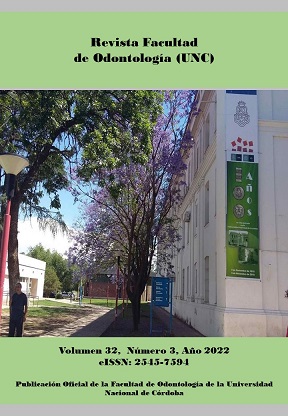Study of properties and structure of gels for topical application in post-extraction tooth sockets
Keywords:
Alendronate, Arnica montana, gel characterizationAbstract
The process from an active ingredient to the final medicine requires pre-formulation and stability studies of the product developed under different conditions, as well as the standardization of the extract as raw material. The objective of this work was to characterize formulations for topical application (gels), for use in post-extraction tooth sockets. Materials and methods: The gels were made according to good laboratory practice standards. The pH of the gel formulations was measure with a pH meter (Eutech, Cyberscan) using 1% aqueous solutions of the gels at room temperature. Extensibility was determined with a wooden block and glass slide apparatus. The gel was added and the time it took too completely separate from the fixed was note. The spreading capacity was calculate using formulas (S = W × L / T) The measurement of the consistency of the gels was carried out by dropping a cone from a fixed distance of 10 cm in such a way that it lands in the center of a glass cup filled with the gel. Cone penetration was measured from the surface of the gel to the tip of the cone within the gel. The distance traveled by the cone after 10 seconds was recorded. To analyze the superficial topographic characteristics of the gels, photographs were taken with a confocal microscope. Results: All formulations are in a range of pH values close to neutrality (pH 6.4-6.9). The gel prepared with alendronate presented higher extensibility, while the others showed lower extensibility with similarities between them. The consistency analysis showed no differences between the formulations. The selected formulations presented a brown olive-green color with different intensities; they presented a homogeneous appearance to the naked eye, but heterogeneous when observed under a confocal microscope. Conclusions: In the characterization of the gels, show that they have a variable texture and consistency depends on the type and concentration of the active ingredient used. The most suitable gel formulation was alendronate.
References
1. Kaewpinta A, Khongkhunthian S, Chaijareenont P, Okonogi S. Preparation and characterization of rice gels containing tooth-bleaching agent. Drug Discov Ther. 2018; 12(5):275-282. doi: 10.5582/ddt.2018.01057.
2. Okonogi S, Kaewpinta A, Khongkhunthian S, Yotsawimonwat S. Effect of rice variety on the physicochemical properties of the modified rice powders and their derived mucoadhesive gels. Drug Discov Ther. 2015; 9(3):221-8. doi: 10.5582/ddt.2015.01009.
3. Fini A, Bergamante V, Ceschel GC. Mucoadhesive gels designed for the controlled release of chlorhexidine in the oral cavity. Pharmaceutics. 2011; 3(4):665–680.
4. Ortiz Lucio E, Antonio Cruz R, Cruz Gómez J, Mendoza Martínez A. M, Morales Cepeda A. B. Síntesis y caracterización de hidrogeles obtenidos a partir de acrilamida y metilcelulosa. Revista Iberoamericana de Polímeros. 2006; 7(4): 247-253.
5. Deyjak Novak S, Sporar E, Baumgartner S, Vrecer F. Characterization of physicochemical properties of hydroxypropyl methylcellulose (HPMC) type 2208 and their influence on prolonged drug release from matrix tablets. Journal of Pharmaceutical and Biomedical Analysis. 2012; 66:136–143
6. Raszewski Z, Nowakowska-Toporowska A, Weżgowiec J, Nowakowska D. Design and characteristics of new experimental chlorhexidine dental gels with anti-staining properties. Adv Clin Exp Med. 2019; 28(7):885–890.
7. Li J., Mooney D.J. Designing hydrogels for controlled drug delivery. Nat. Rev. Mater. 2016; 1:16071. doi: 10.1038/natrevmats.2016.71.
8. Ho D, Jagdeo J, Waldorf HA. Is There a Role for Arnica and Bromelain in Prevention of Post-Procedure Ecchymosis or Edema? A Systematic Review of the Literature. Dermatol Surg. 2016; 42(4):445-63.
doi: 10.1097/DSS.0000000000000701.
9. Adkison JD, Bauer DW, Chang T. The effect of topical arnica on muscle pain. Ann Pharmacother. 2010; 44(10):1579-84. doi: 10.1345/aph.1P071. Epub 2010 Aug 31. PMID: 20807867.
10. Reddy GT, Kumar TM, Veena KM. Formulation and evaluation of alendronate sodium gel for the treatment of bone resorptive lesions in periodontitis. Drug Deliv. 2005; 12:217–22.
11. Kim BS, Shkembi F, Lee J. In Vitro and In Vivo Evaluation of Commercially Available Fibrin Gel as a Carrier of Alendronate for Bone Tissue Engineering. Biomed Res Int. 2017; 2017:6434169. doi:10.1155/2017/6434169
12. Bergamante V, Ceschel GC, Marazzita S, Ronchi C, Fini A. Effect of Vehicles on Topical Application of Aloe Vera and Arnica Montana Components. Drug Delivery. 2007; 14:7, 427-432
Downloads
Published
Issue
Section
License

This work is licensed under a Creative Commons Attribution-NonCommercial-ShareAlike 4.0 International License.
Aquellos autores/as que tengan publicaciones con esta revista, aceptan los términos siguientes:
- Los autores/as conservarán sus derechos de autor y garantizarán a la revista el derecho de primera publicación de su obra, el cuál estará simultáneamente sujeto a la Licencia de reconocimiento de Creative Commons que permite a terceros:
- Compartir — copiar y redistribuir el material en cualquier medio o formato
- La licenciante no puede revocar estas libertades en tanto usted siga los términos de la licencia
- Los autores/as podrán adoptar otros acuerdos de licencia no exclusiva de distribución de la versión de la obra publicada (p. ej.: depositarla en un archivo telemático institucional o publicarla en un volumen monográfico) siempre que se indique la publicación inicial en esta revista.
- Se permite y recomienda a los autores/as difundir su obra a través de Internet (p. ej.: en archivos telemáticos institucionales o en su página web) después del su publicación en la revista, lo cual puede producir intercambios interesantes y aumentar las citas de la obra publicada. (Véase El efecto del acceso abierto).

